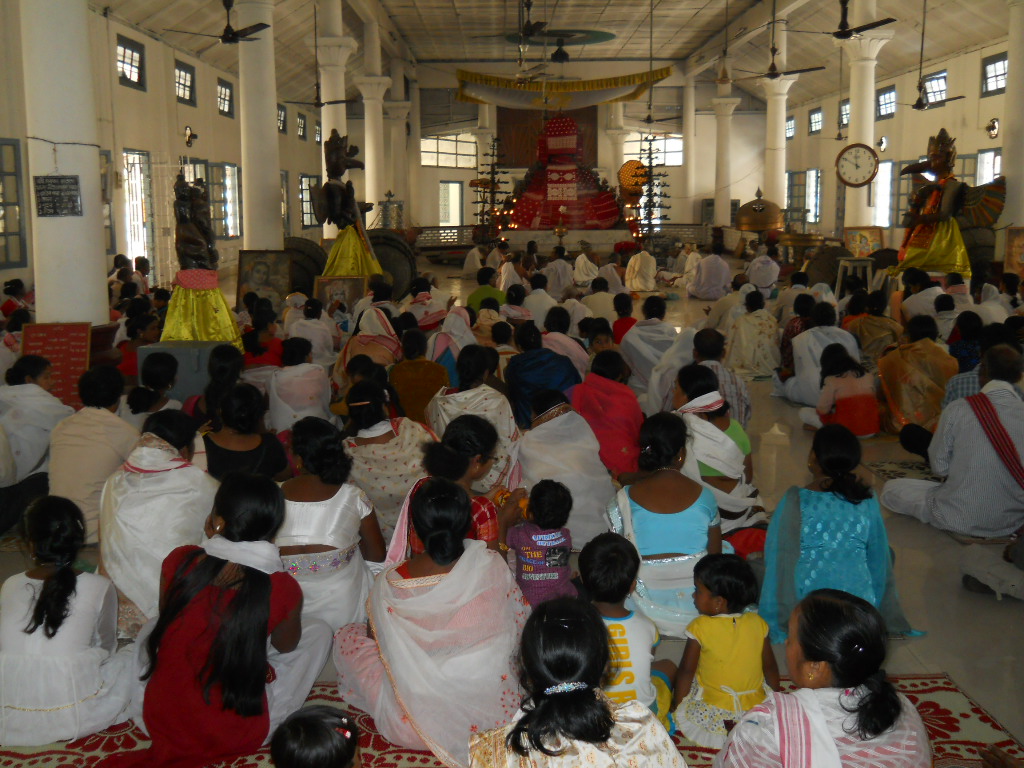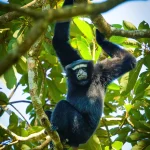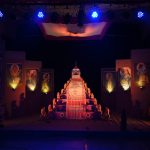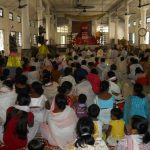Srimanta Sankaradeva created a new religion, Eka Sarana Nâma Dharma. But he was not a religious preceptor alone. He had multi-faceted talent in the disciplines of dance, music, drama, verses etc. He also created a new social structure. He may be placed among the all time greats in the world for his role in social reform alone. The time when he was born in was a time of terror and tyranny. There was no guarantee of human lives in those trying times of medieval period. Different Tântric practices like human sacrifice, Bhogi etc devastated the social life of the Brahmaputra valley. Human sacrifices were made in several temples of Brahmaputra valley in the medieval period. Some of these were Kamakhya temple, Ekajata temple, Tara temple, Deoshal etc. The people of Kachari tribe, Deuri tribe, Chutiya tribe, and Ahom tribe sacrificed human beings in the Tamreswari temple or Pichachi temple or Kechaikhati temple of Sadiya. The people of Koch tribe also sacrificed human beings. The Ahom kings gave human sacrifice at the time of coronation.1 Only healthy youths were sacrificed. Such youths were looked after very well before being sacrificed. All their wishes were fulfilled. Such youths were known as Bhogi. A Bhogi could have sexual intercourse with any female in the kingdom. So the women of the Brahmaputra valley could not live a life of honour in the medieval period.
Another regressive custom of the medieval era was the virgin worship. This worship was performed in Tântric method. So the Shakti temples and the Shiva temples became centres of immoral practices. The Devadâsi, the female worshippers in these temples were gradually degraded to the status of prostitutes.2 Such immoral activities spoiled the entire atmosphere of the society and led to the downfall of the young generations. Naturally such an atmosphere was conducive for the feudal lords, since they did not have to take recource to any extra measure for keeping the people under tab. So we can say that the Tântric Gurus were implicit allies of the feudal lords in the medieval period.
Srimanta Sankaradeva preached a monotheism devoid of any sacrifice. In doing so, he had the dual purposes of preventing the above two doformities in the society. He advised people to worship lord Krishna by giving up the worship of other lesser deities. There was no need to sacrifice any creature in the worship of lord Krishna. Actually the proponents of animal sacrifices have been offering a wrong interpretation of the Purusha-sukta of Veda. Actually the Purusha-sukta calls upon people to sacrifice their demerits. But the Tântrics misinterpreted it as sacrifice of animals. Srimanta Sankaradeva said repeatedly that there was no need of animal sacrifice in the worship of lord Krishna. He wrote many frightening words in his writings in order to dissuade people from sacrificing animals. He wrote that the animals one sacrifice in the present birth take revenge on one in later births. The saint offered a simple method of worshipping lord Krishna based on Shravana-Kirtana, listening and chanting the name of God. No offering was necessary in this worship except devotion. The Eka Sarana Nâma Dharma became very popular for this simplicity. As a result the Shakti worship was on the wane.
Most of the people were illiterate in those days. They were very backward intellectually. It was not always possible to explain the tenets of religion elaborately to these illiterate people, who were ignorant about the scriptures. So Srimanta Sankaradeva devised a tactic to dissuade these people from worship of lesser deities, where sacrifice of creatures was involved. He debarred his disciples from visiting the places where worship of any lesser deity took place. Seeing the idol of any lesser deity was also prohibited. Anya devi deva nakaribâ seva Nakhâibâ prasâda târa Murtiko nachâibâ Griho napashibâ Bhakti haiba byabhichâra (Bhâgavata/2/545) [Meaning – Do not bow before other gods and goddesses and do not take offerings of theirs also. Do not even look at their idols nor enter their houses. The devotion (to lord Krishna) will be compromised if you do so.]
Srimanta Sankaradeva taught the people practically how they should sacrifice the animal within them and not sacrifice any living being. Thus he followed in the foot-step of the Purusha-sukta. Once he asked Madhavadeva, the foremost disciple of the saint to fetch a human beast. But some conditions were laid down too. Madhavadeva could not use any arrow. The animal could not be either dead or alive. The next day Madhavadeva submitted himself as the human beast. He understood the philosophical meaning of his preceptor’s directive. Srimanta Sankaradeva was overwhelmed at Madhavadeva’s perception.3 Thus Srimanta Sankaradeva and Madhavadeva gave a nice interpretation of the animal mentioned in the Purusha-sukta. So the true meaning of Veda was preserved in the Eka Sarana Nâma Dharma, not in the Shakti cult, where animal sacrifice is indispensable.
The Eka Sarana Nâma Dharma, devoid of worship of female deities helped immensely in the prevention of distorted sexual practices in the then society. There was no provision of virgin worship, the root cause of all such regressive customs, in the Eka Sarana Nâma Dharma. But all other Vaishnavite orders of India accepted worship of female deities by some means or other. Even the Alwars sang glory of Devi. The Devi worship is totally absent only in the Eka Sarana Nâma Dharma.4 It is the only true Vaishnavite order, because the concept of Eka Sarana is not found in any other Vaishnavite order. The Devi is worshipped along with lord Krishna in all other Vaishnavite orders. Such worships created scope for moral decay among the devotees. The Sahajiyâ cult of Bengal is an instance of that. The Sahajiyâ cult penetrated Assam also to some extent. That was why the Devadâsis started being treated as prostitutes. Unlike these cults, the Eka Sarana Nâma Dharma accord a high status to women. The women followers in the Eka Sarana Nâma Dharma can read scriptures, prepare holy offerings to God, and perform Nâm-prasanga in Kirtanghar, the community prayer hall unlike in other orders. No such priviledge is given to women in any other religious order. Srimanta Sankaradeva himself initiated several women in the Eka Sarana Nâma Dharma. Khersuti, Kâlindi, Châkuli Bâyan, Bârâbâhi Thâkur, wife of Madhai, wife of Rupa Goswami etc were some of them. The saint declared equal rights of women even in his writings. Such mention is found in his first composition Harishchandra Upâkhyâna itself. So both male and female were given equal rights in the Eka Sarana Nâma Dharma. It was even said that devotion became fruitful only when both male and female happened to be of the same disposition. Thus Srimanta Sankaradeva tried to establish an orderly society by giving a place of honour to women.5 An organizer like Kanaklata and a litterateur like Padmapriya could emerge in the Eka Sarana Nâma Dharma only because of such an ideology of Srimanta Sankaradeva. Such instances are rare in other religious orders. That Srimanta Sankaradeva accorded a high status to women was also proved by his engagement of a woman as leader of the volunteer force during the construction of dam at Tembuwani. A earthen dam was constructed over the river Tembuwani since water of Brahmaputra entered through it and inundated the entire Tembuwani. It was then that Srimanta Sankaradeva asked a woman to start the work of pouring soil onto the river. Her name was Yogamaya or Radhika. Srimanta Sankaradeva presented golden jewellery to her after the completion of the dam.6
Removal of caste difference was one of the most important aspects of Srimanta Sankaradeva’s social reforms. The caste difference was very severe when the saint was born. Only the sons of Brahmin and Kayastha families could be enrolled in a Tol, the then residential school. That social hiatus was done away with in the Eka Sarana Nâma Dharma. The revolutionary activities undertaken by Srimanta Sankaradeva removed caste disparity from the Brahmaputra valley. He established a Kirtanghar at Tembuwani in 1468 AD. This institution of community prayer hall turned to the main institution of national life of Assam over time. This innovative social institution encompassed different aspects like religion, culture, social issues, and even justice. People of all castes sat together in the Kirtanghar. Thus all caste differences disappeared from the society within the precinct of Kirtanghar. Srimanta Sankaradeva accorded equal importance to the so-called low castes. The most important example of that was Radhika, the first volunteer in the construction work of the dam on Tembuwani. She was a Kaivarta lady. The Kaivarta caste was considered as a low caste in those days. That Srimanta Sankaradeva selected her as the leader of the volunteers proved his egalitarian ideology. It may be mentioned that his younger brother Banganya married a Kaivarta lady. Srimanta Sankaradeva was present in that wedding. That he blessed the inter-caste marriage was another sign of his progressive attitude. He tried his utmost to build up a casteless society. He even allowed Radhika and her husband to build a residence beside his own campus.7
The people of high castes looked down upon the tribal people, who remained outside the caste system.8 Srimanta Sankaradeva embraced all those ignored tribes with love. There was no artificiality in that embrace. This is proved by the fact that the most close confident of the saint happened to be a tribal person, Paramananda, who belonged to the Mising tribe. Paramananda was an inhabitant of Majuli and his earlier name was Pangkong. Srimanta Sankaradeva took some concepts from the Murang-ghar of the Mising tribe while visualizing his own Kirtanghar.9 Such acts were revolutionary steps in the then medieval society, because the high caste people of the Sanâtana religion looked down upon the tribal culture till then. It was only Srimanta Sankaradeva, who removed that attitude. He built amity between the tribal people and the non-tribal people of the Brahmaputra valley for the first time. That went on to build the great Assamese race. Moreover the saint reduced ethnic conflicts from the valley by bringing about amity among the different tribes. That was an important achievement from the view point of social reform.
Srimanta Sankaradeva made a conscious effort to remove social conflicts. He exhorted people to give up demonic nature in his writings. Hena jâni asura swabhâva save eri Samasta prânika pujâ Vishnu buddhi kari (Kirtana-ghoshâ/359) [Meaning – You all people should give up demonic nature after knowing this. Worship all creatures by considering them as forms of lord Vishnu.]
Srimanta Sankaradeva spoke frequently about ethics and principles in his writings for the same reason. It was necessary to restrain the disorderly people of those days with the bindings of ethics. So ethics constituted an important component of his writings.10 Teachings of ethics found special importance in his Kirtana-ghoshâ. Moreover the Bargeets and the Ankiyâ plays also advised people to live sanskritized lives. All these were nothing but reform activities. The feudalism is considered as a regressive and backward social system. People of the twenty first century are regulated by the concepts of democracy and socialism. But these modern concepts had not developed in the medieval period. Feudalism was the ruling pattern of social system in those days. The king had total right over the subjects in those days. Moreover there were many strata in the society. But even in such a time Srimanta Sankaradeva showed a socialist ideology. All devotees were accorded the same status inside the Kirtanghar or Nâmghar established by the saint. Srimanta Sankaradeva himself had come down from the level of a king to that of the commoners. He was earlier the Shiromani-Bhuyân or king of the Bhuyân kingdom. But he renounced that status and showed an example of egalitarianism. He refused to accept Koch king Naranarayana as his disciple towards the end of his life for the same reason. Naranarayana had not been able to get over his ego. He had not solicited Sarana from Srimanta Sankaradeva, but ordered the latter to initiate him. There was no chance at all of such a king sitting together with other devotees in the Kirtanghar. Srimanta Sankaradeva decided to stick to his own ideology. He refused to accept Naranarayana as a disciple.11 He renounced a rich disciple named Sivananda Laskar for a similar reason.12 There was no place of money and aristocracy in the Eka Sarana Nâma Dharma.
Srimanta Sankaradeva initiated a work culture in the society in place of the prevailing exploitative culture of feudalism. Generally a religious Guru is not engaged in any productive work. He procures all his requisite materials from his followers. But Srimanta Sankaradeva procured his requisite foodgrains from his own agricultural land. He engaged labourers for agricultural works. They were engaged in cultivation of paddy, mustard seeds etc. Madhavadeva, the foremost disciple of the saint sometime supervised these agricultural works. Both Srimanta Sankaradeva and Madhavadeva assisted the weavers of Tantikuchi in creating floral designs on cloth.13 Srimanta Sankaradeva helped an artisan at Bardowa in construction of Khol, a musical instrument innovated by him. All these point to a work culture, not a feudal culture. But some leftist authors of Assam have deliberately been terming Srimanta Sankaradeva as of feudal temperament. This analysis is deliberate and motivated.14 Actually Srimanta Sankaradeva was a victim of feudalism. An Ahom king beheaded his son-in-law Hari. Another Koch king threatened to kill the saint. Srimanta Sankaradeva had to hide several times in his life in order to escape from royal persecution. So he was well aware of the negative side of feudalism. As a result, he did not give any leeway to the feudal lords. That was a revolutionary step in the medieval period. The Mowamariyas could rise against the persecution of Ahom king only because of this ideology bequeathed by Srimanta Sankaradeva.
We can claim that the Brahmaputra valley remained comparatively free from caste differences, class differences, ethnic conflicts etc compared to other regions of the country because of the reform activities done by Srimanta Sankaradeva. Even Mahatma Gandhi admitted that the ideology of Râm-Râjya, which was his ideology too, had been given by Srimanta Sankaradeva to the people of Assam long ago.15 This admission by the best social reformer of modern India establish the greatness of Srimanta Sankaradeva. The impact of the saint remains indelible in the Assamese society even five centuries later due to that greatness. So the people of Assam remember him gratefully as father of the Assamese race as well as Jagadguru.
References and notes
1. Asomor sânskritik itihâs, Jatindra Kumar Borgohain, First edition, Jorhat, 1989 AD, pp. 22-28.
2. Ibid, pp. 17-20.
3. Kathâ Gurucharit, Chakrapani Vairagi, composed in about 1758 AD, edited by Upendra Chandra Lekharu, 15th edition, Guwahati, 1987 AD, pp. 104-105.
4. Absence of Shakti worship : a unique feature of Eka Sarana Nâma Dharma of Srimanta Sankaradeva, Dr Sanjib Kumar Borkakoti, in Mahâpurusa Jyoti, Journal of Srimanta Sankaradeva Sangha, edited by Dr. Suresh Chandra Bora, Volume V, Nagaon 2003 AD.
5. Eka Sarana Nâma Dharmat nârir sthân, Dr Sanjib Kumar Borkakoti, in âmar Asom, edited by Dr. Nagen Saikia, Guwahati, January 18, 2005 AD.
6. Mahâpurusha Srimanta Sankaradeva, Dr Sanjib Kumar Borkakoti, First edition, Guwahati, 2005 AD, pp. 20-21. Several hagiographies have written that Radhika had poured water. But we have proved from comparative study that she actually poured soil.
7. We have unearthed many such informations from our comparative study. All these informations have been compiled in our research based books.
8. Even in the modern era, authors like Dr Banikanta Kakoti and Bhaben Barua have given derogatory comments about the tribes of Assam, which is extremely unfortunate and condemnable. As a result, the tribal people have started saying that they are not Assamese. But these petty intellectuals do not represent the general thinking of the Assamese people.
9. Janajâtiya Mising kristi âru Asomor vaishnava sanskritir mâjat binimaya, Dr Sanjib Kumar Borkakoti, in Kalpataru, edited by Pranab Kumar Barua, Nagaon January, 2005 AD.
10. Shikshâvid Srimanta Sankaradeva, Dr Sanjib Kumar Borkakoti, in Agradoot, edited by Kanaksen Deka, Guwahati, September 15, 1996 AD.
11. Jagadguru Srimanta Sankaradeva, Dr Sanjib Kumar Borkakoti, First edition, Moran, 2003 AD, pp. 61-62.
12. Mahâpurusha Srimanta Sankaradeva, Dr Sanjib Kumar Borkakoti, First edition, Guwahati, 2005 AD, pp. 203, 205-206.
13. Ibid, pp. 58-59, 223.
14. We have written several articles where we countered these disinformations. These have been compiled in a book. Sankaradeva adhyayanat bisangati, Dr Sanjib Kumar Borkakoti, First edition, Guwahati, 2005 AD.
15. Mahatma Gandhi said, “Assam, indeed, is fortunate, for Sankaradeva has five centuries back, given the Assamese people an ideal which is also my ideal of Ram-Rajya.”
Acknowledgement :
This article was earlier published in the website www.sankaradeva.com




